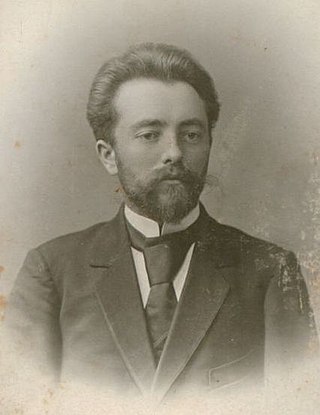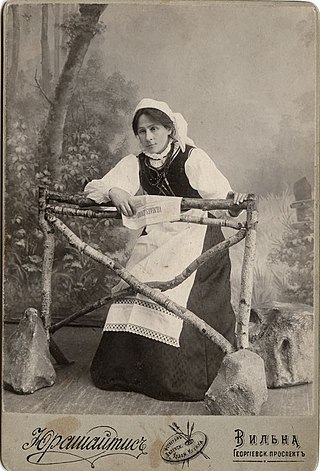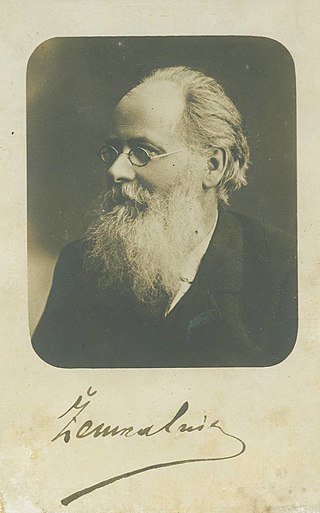Lietuvos žinios was a daily newspaper in Lithuania. Established in Vilnius in 1909, it was a liberal newspaper representing the Lithuanian Democratic Party. Even though its publication was interrupted by World War I and Soviet occupation of Lithuania, Lietuvos žinios billed itself as the oldest newspaper in Lithuania.

Varpas was a monthly Lithuanian-language newspaper published during the Lithuanian press ban from January 1889 to December 1905. Because its publication was illegal in Lithuania, then part of the Russian Empire, it was printed in Tilsit and Ragnit in German East Prussia and smuggled into Lithuania by the knygnešiai. Varpas, with circulation of about 500 to 1,000 copies, played a pivotal role in the Lithuanian National Revival. Tautiška giesmė, one of poems by founder and editor Vincas Kudirka written to commemorate the 10th anniversary of Varpas, became the Lithuanian national anthem. Editorial staff of Varpas later started two more specialized publications: more practical Ūkininkas for less educated peasants and apolitical Naujienos for general public.

Šatrijos Ragana was the pen name of Marija Pečkauskaitė, a Lithuanian humanist and romantic writer and educator. Her most successful works are Sename dvare and Irkos tragedija.

The Lithuanian Democratic Party was a political party in Lithuania. The original party was established in 1902. It published newspapers Lietuvos ūkininkas (1905–1918) and Lietuvos žinios (1909–1915). During World War I, the party split into several other parties and was disbanded in 1920. A new party under the same name was established in 1989.

Vilniaus žinios was a short-lived newspaper published in Vilnius, Lithuania. It was the first legal Lithuanian-language daily newspaper to appear after the Lithuanian press ban was lifted on May 7, 1904.

Povilas Višinskis was a Lithuanian cultural and political activist during the Lithuanian National Revival. He is best remembered as a mentor of literary talent. He discovered Julija Žymantienė (Žemaitė) and advised Marija Pečkauskaitė, Sofija Pšibiliauskienė, Gabrielė Petkevičaitė (Bitė), Jonas Biliūnas, Jonas Krikščiūnas (Jovaras), helping them edit and publish their first works.

Gabrielė Petkevičaitė was a Lithuanian educator, writer, and activist. Her pen name Bitė (Bee) eventually became part of her last name. Encouraged by Povilas Višinskis, she joined public life and started her writing career in 1890, becoming a prominent member of the Lithuanian National Revival. She was the founder and chair of the Žiburėlis society to provide financial aid to struggling students, one of the editors of the newspaper Lietuvos žinios, and an active member of the women's movement. In 1920, she was elected to the Constituent Assembly of Lithuania and chaired its first session. Her realist writing centered on exploring the negative impact of the social inequality. Her largest work, two-part novel Ad astra (1933), depicts the rising Lithuanian National Revival. Together with Žemaitė, she co-wrote several plays. Her diary, kept during World War I, was published in 1925–1931 and 2008–2011.

Sofija Pšibiliauskienėnée Ivanauskaitė and Marija Lastauskienė were two Lithuanian sister writers of Polish origin, using the same pen name Lazdynų Pelėda.

Naujienos was a short-lived Lithuanian-language monthly newspaper published by editorial staff of Varpas and Ūkininkas. Due to the Lithuanian press ban in the Russian Empire, the newspaper was published in Tilsit in East Prussia and then smuggled to Lithuania by knygnešiai. In 1903, its circulation was around 1,500.
Lietuvos ūkininkas was a weekly Lithuanian-language newspaper published between 1905 and 1940. It was published by and reflected the political views of the Lithuanian Democratic Party, Peasant Union, and Lithuanian Peasant Popular Union. Its printing and daily operations were managed by its long-time publisher Felicija Bortkevičienė. It was a liberal publication geared towards the wider audience of less educated farmers and peasants. In 1933, its circulation was 15,000 copies. When Lithuania was occupied by the Soviet Union in 1940, the newspaper was nationalized and replaced by Valstiečių laikraštis.

Petras Avižonis was a Lithuanian ophthalmologist, rector of the University of Lithuania (1925–1926) and a political figure.

Pranas Vaičaitis was a Lithuanian poet. After graduation from the Marijampolė Gymnasium, he studied law at the Saint Petersburg University. Due to the violations of the Lithuanian press ban, he was imprisoned for a month in 1899 and could not find a jurist job.

Jonas Krikščiūnas known by his pen name Jovaras was a Lithuanian poet. From around 1896 to 1904, he was a book smuggler helping distribute the banned Lithuanian books. A son of poor peasants, he never received any formal education. He learned to read at home and with financial support from Žiburėlis studied privately in 1907–1910. In 1901, he met with Povilas Višinskis who taught him the basics of poetry. Krikščiūnas wrote most of his works in 1904–1910. Eight different poetry collections were published before World War I. His poetry built on the traditions of the Lithuanian folk songs. Two of his best known poems were adapted into folk songs. During the Russian Revolution of 1905, his works reflected struggles and suffering of the common people and socialist ideology. His later poems repeated socialist–communist slogans.
America in the Bathhouse is a three-act comedy by Keturakis. The play was first published in 1895. It became the first Lithuanian-language play performed in public in present-day Lithuania when a group of Lithuanian activists staged it on 20 August 1899 in Palanga. The play depicts an episode from the everyday life of the Lithuanian village – a resourceful man swindles money from a naive woman and escapes to the United States. Due to its relevant plot, small cast, and simple decorations, the play was very popular with the Lithuanian amateur theater. It became one of the most popular and successful Lithuanian comedies of all time and continues to be performed by various troupes.

Gabrielius Landsbergis-Žemkalnis (1852–1916) was a Lithuanian playwright and activists of the early Lithuanian amateur theater.

Jonas Kriaučiūnas was a Lithuanian activist during the Lithuanian National Revival mostly noted for editing and publishing Lithuanian periodicals Varpas and Ūkininkas in 1891–1895 and Vilniaus žinios in 1905–1906.

Jadvyga Teofilė Juškytė (1869–1948) was a Lithuanian activist during the Lithuanian National Revival.

Vladas Putvinskis or Vladas Pūtvis was a Lithuanian paramilitary leader, one of the founders and first chairman of the Lithuanian Riflemen's Union.

Andrius Bulota was a Lithuanian lawyer and politician in the Russian Empire. He was a member of the Second and Third Russian State Dumas (1907–1912) and the Russian Constituent Assembly (1918).

Marta or Morta Zauniūtė was a Lithuanian press activist in Lithuania Minor. She is best remembered as the administrator of Lithuanian newspapers Varpas, Ūkininkas, and Naujienos from 1900 to 1905. Due to the Lithuanian press ban, these publications were printed in East Prussia and smuggled to Lithuania.




















